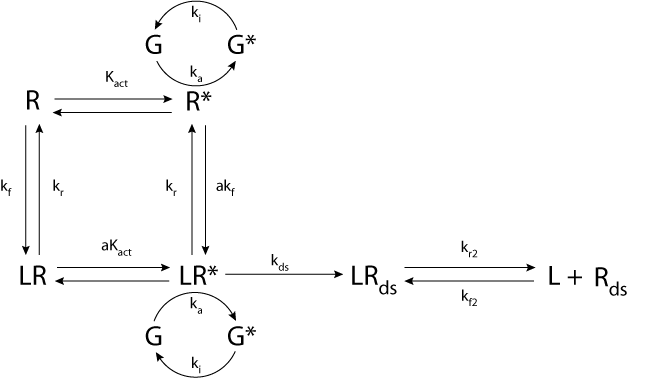Location: Riccobene, Omann, Linderman, 1999 @ ade691720cc0 / riccobene_1999.html
- Author:
- Hanne Nielsen <hnie010@aucklanduni.ac.nz>
- Date:
- 2011-09-13 11:41:40+12:00
- Desc:
- Added session file
- Permanent Source URI:
- https://models.physiomeproject.org/workspace/riccobene_omann_linderman_1999/rawfile/ade691720cc08b4709dac598db6649fe3e1785d3/riccobene_1999.html
Model Status
This CellML model has been recoded to remove the reaction element. The model is known to run in both PCEnv and COR to recreate the published results. The units have been checked and are consistent.
Model Structure
ABSTRACT: Signalling through G-protein coupled receptors is one of the most common and most important methods of transmitting information to the inside of cells. Many mathematical models have been published to describe this type of signal transduction, but the kinetic model described by Riccobene, Omann and Linderman (1999) is unique in that it includes the dynamics of G-protein activation and desensitisation, in addition to considering active and inactive receptor states (see the figure below). The model was used to predict how different ligands would affect the nature of the signal transduction response.
The original paper reference is cited below:
Modeling Activation and Desensitization of G-Protein Coupled Receptors Provides Insight into Ligand Efficcacy, Todd A. Riccobene, Geneva M. Omann, Jennifer J. Linderman, 1999, Journal of Theoretical Biology, 200, 207-222. PubMed ID: 10504286

|
| A schematic diagram of Riccobene, Omann and Linderman's model of G-protein coupled receptor signalling. R is the inactive form of the receptor, R* is the active form of the receptor, Rds is the desensitised form of the receptor, L represents the ligand (in this case, N-formyl-norleucyl-leucyl-phenylalaninyl-nor-leucyl-tyrosyl-lysine-fluorescein, or CHO-NLFNTK-fl), G is the inactive G-protein, G* is the activated G-protein, and LR/LR*/LRds represents the ligand/receptor complex in its various forms. |
